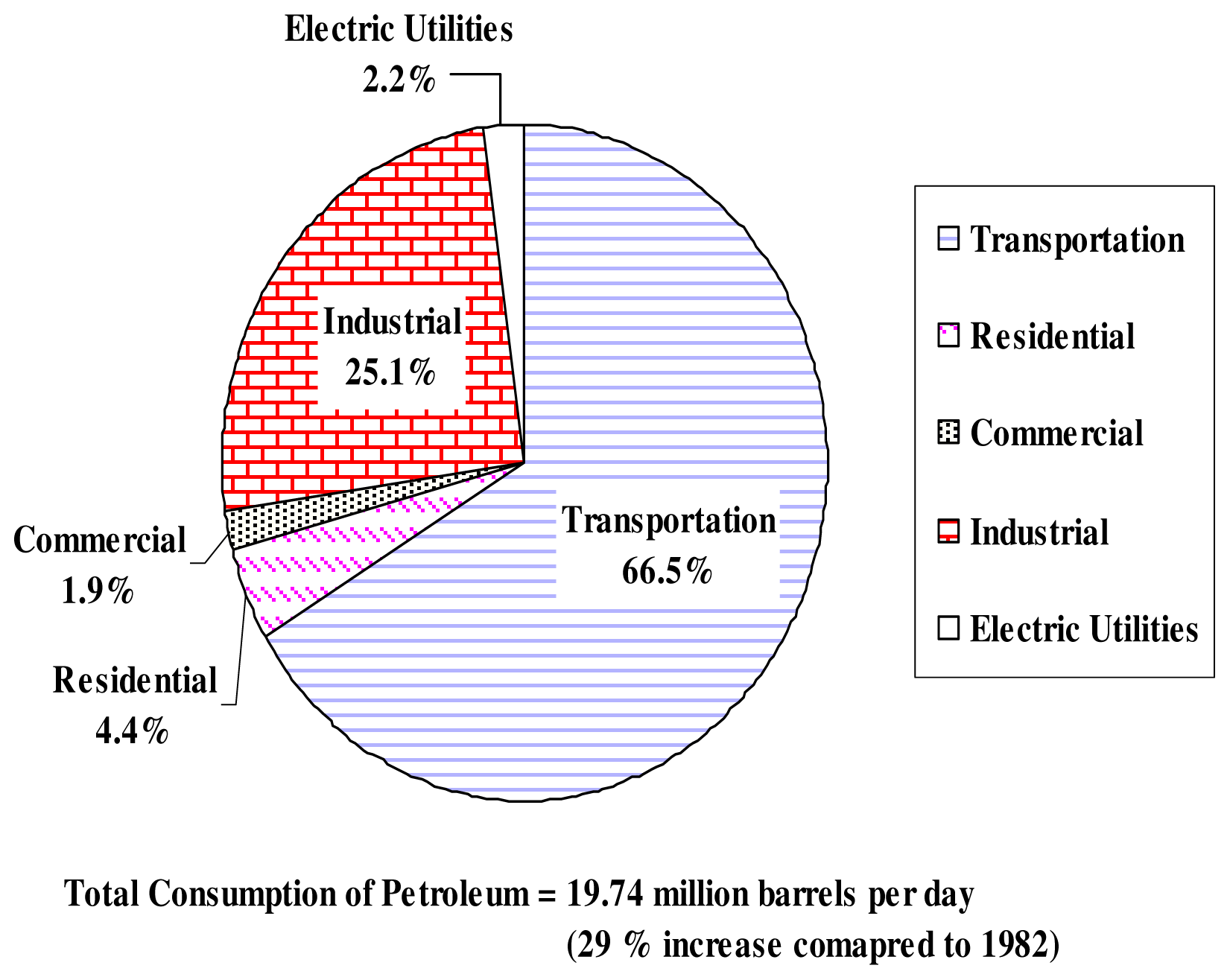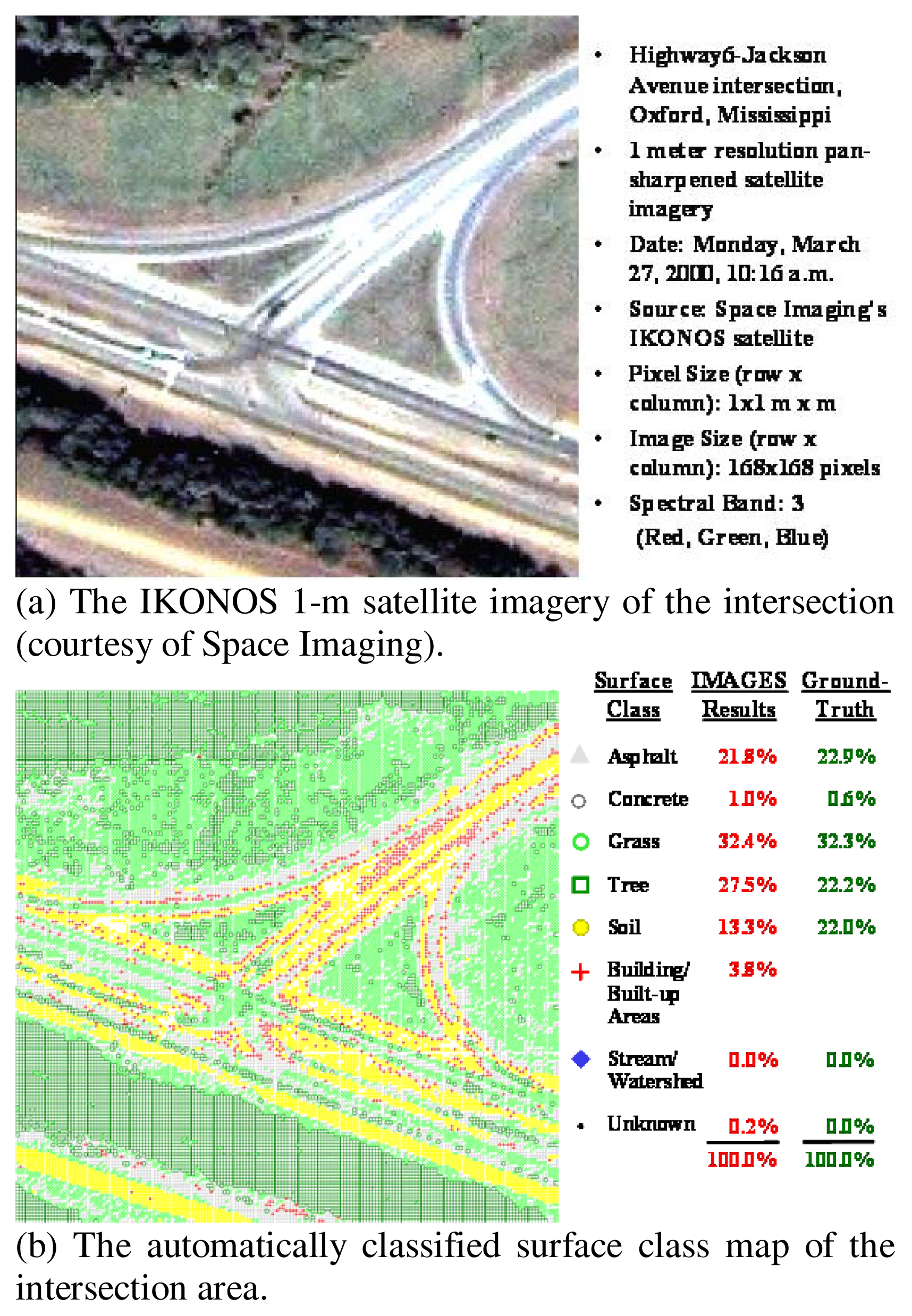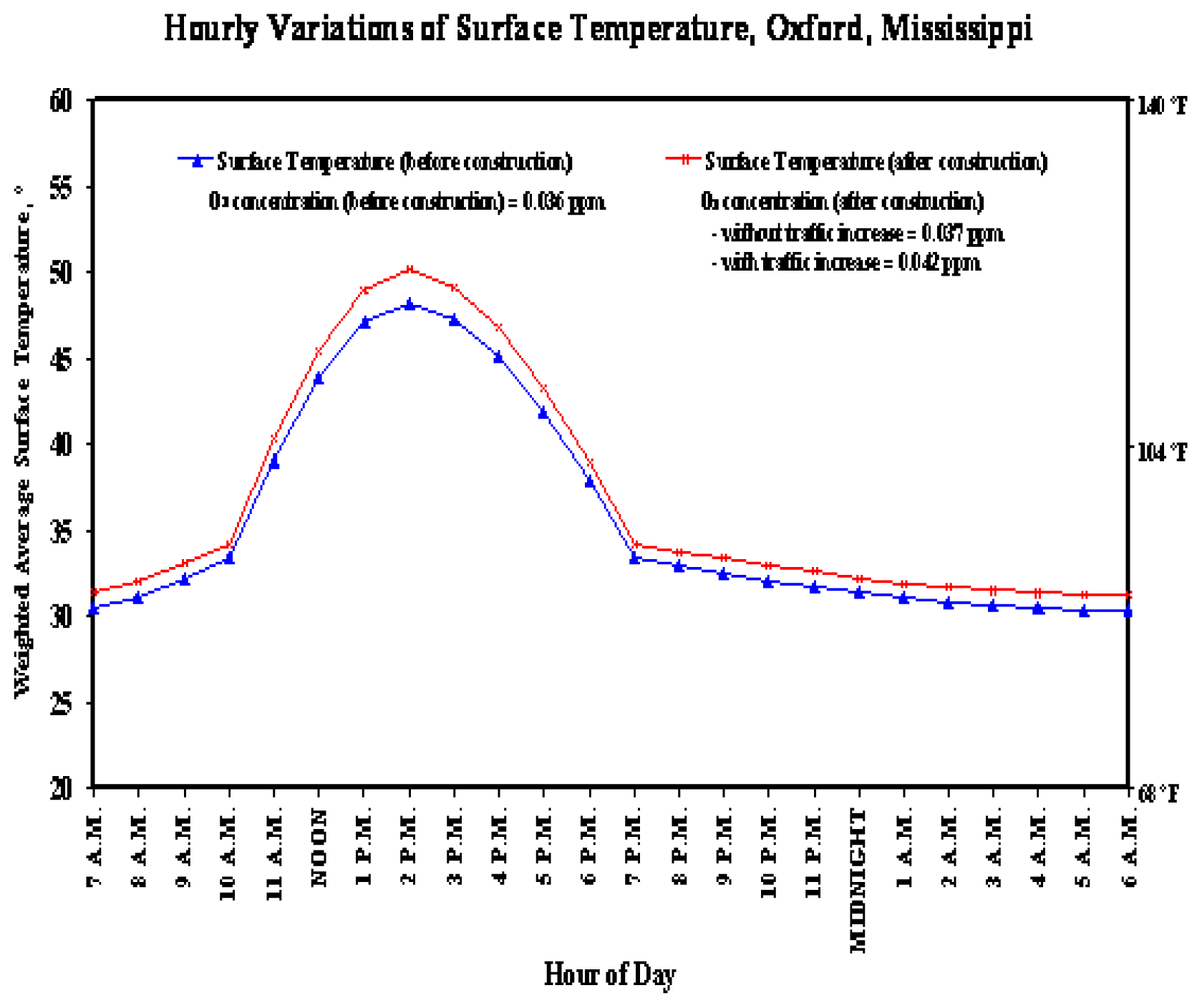Air Quality Management Using Modern Remote Sensing and Spatial Technologies and Associated Societal Costs
Abstract
:Introduction
Factors Associated with Environmentally Sustainable Transportation
Safety Impacts of Traffic Related Crashes
Built Environment Impacts on Physical Inactivity and Air Pollution
Air Pollution Impacts on Public Health
Life-Cycle Analysis of Societal Costs and Economic Benefits
Evaluation of Societal Costs
Evaluation of Benefits
- Reduction of accidents: An improved travel surface, the construction of a new intersection, or the construction of a new bypass are some projects that will reduce accidents and increase benefits.
- Reduction of congestion: The first factor considered in the evaluation of benefits is the level of service (LOS). Increasing the number of lanes of an existing highway will improve the traffic flow, reduce the congestion, and provide better LOS.
- Reduction of travel time: The travel time and the user costs are reduced due to an improved traffic flow or a new bypass.
- Reduction of vehicle emissions: The improved traffic flow and reduced congestion will decrease the amount of vehicle emissions and air pollution.
- Reduction of air pollutants: The reduction in air pollution will result in reduced public health costs. In addition, air pollution is harmful to agricultural products and ecosystems, and even deteriorates constructed materials and structures. The decrease in these undesirable consequences, therefore, can be considered as a benefit to the society [20].
Case Studies of Life-Cycle Societal Benefits and Costs
Air Quality Modeling and Analysis Methodology
AQMAN Model Development
- Climatological data (air temperature, wind, precipitation, solar radiation, cloud cover)
- Daily traffic data (volume, traffic mix, average speed of cars and trucks)
- Daily vehicle emissions of VOC and NOx (function of vehicle model year in traffic mix)
- Daily emission inventory estimates of VOC and NOx from industrial sources
- Daily estimates of aircraft operations at airports in the study area
- Daily surface temperature (weighted average from classification of surface types)
Application of Remote Sensing and Geospatial Technologies
Results of a Case Study of the Impact of Built-up Area on Societal Costs
Discussions and Concluding Remarks



| Air Pollutant | Endpoint of Public Health Effect | Economic Valuation -- mean estimate – (in 1990 dollars) | |
|---|---|---|---|
| PM | Mortality | $4,800,000 | per case* |
| PM | Chronic Bronchitis | $260,000 | per case |
| Ozone | Chronic Asthma | $25,000 | per case |
| PM, Ozone, NO2, SO2 | All Respiratory | $6,900 | per case |
| PM, Ozone, NO2, SO2, CO | All Cardiovascular | $9,500 | per case |
| PM & Ozone | Emergency Room visits for Asthma | $ 194 | per case |
| PM | Acute Bronchitis | $45 | per case |
| PM & Ozone | Acute Asthma; Respiratory Illness and Symptoms | $32 | per case |
| PM, Ozone, NO2, SO2 | Acute Respiratory Symptoms | $18 | per case |
| PM | Upper Respiratory Symptoms | $19 | per case |
| PM | Lower Respiratory Symptoms | $12 | per case |
| PM & SO2 | Shortness of Breath, Chest Tightness, or Wheeze | $5.30 | per day |
| PM | Work Loss Days | $83 | per day |
| PM & Ozone | Mild Restricted Activity Days | $38 | per day |
| Welfare Benefits | |||
| DeciView | Visibility | $14 | per unit change in DeciView |
| PM | Household Soiling | $2.50 | per household per PM10 change |
| Ozone | Decreased Worker Productivity | $1 | ** |
| Ozone | Agriculture (Net Surplus) | Change in Economic Surplus | |
| Differential Societal Costs (Costs After – Costs Before) | |
|---|---|
| Impact | Economic Value, 2003 $ |
| 2 cases of chronic asthma | 121,998 |
| 48 cases of acute respiratory symptoms | 24,192 |
| 2 cases of acute cardiovascular symptoms | 36,774 |
| Decrease in 1,511 outdoor workers productivity | 4,758 |
| Traffic accident-related costs (81 % of total cost) | 807,202 |
| Total cost, 2003$ | 994,924 |
Acknowledgements
References
- Uddin, W.; Boriboonsomsin, K.; Garza, S. Transportation related environmental impacts and societal costs for life-cycle analysis of costs and benefits. IJP – International Journal of Pavements 2005, 4(1–2), 92–104. [Google Scholar]
- U.S. DOT: Federal Highway Administration, Fiscal year 2003 performance plan; Publication No. FHWA HCM-02-001; U.S. Department of Transportation, Federal Highway Administration, 2002.
- Stacy, C.D.; Diegel, S.W. Transportation energy data book: Edition 24. In ORNL-6793; Oak Ridge National Laboratory, 2003. [Google Scholar]
- Metschies, G.P. Fuel prices and taxation; GTZ: Germany, 1999. [Google Scholar]
- Physical conditions of the interstate highway system have improved, but congestion and other pressures continue. In Highway Infrastructure, Report Number GAO-02-1128T; General Accounting Office (GAO): Washington, DC, 2002.
- Environmental Protection Agency USA. 2003. http://www.epa.gov/air/airtrends/2003ozonereport/lookat2003.html#measuring.
- World Health Organization. World report on road traffic injury prevention. 2004. http://www.who.int/world-health-day/2004/infomaterials/world_report/en/summary_en_rev.pdf.
- Deadliest states for driving - Rural states, especially in the West, have the highest traffic fatality rates. CNN/Money. 2004. http://money.cnn.com/2004/08/26/pf/autos/state_traffic_deaths_table/index.htm.
- Strategies for improving roadside safety. In Research Results Digest 220; Transportation Research Board, National Research Council: Washington, DC, 1997.
- Does the built environment influence physical activity? Examining the evidence. In TRB Special Report 282; The National Academies Press: Washington, DC, 2005.
- Heat Island Group. http://eande.lbl.gov/HeatIsland/ Accessed April 2, 2003.
- U.S. Environmental Protection Agency. National air quality and emissions trends. Report, EPA-454/R-98-016. 1997. www.epa.gov/oar/aqtrnd97 Accessed on April 13, 2003.
- Rudolph, K. Air quality management in metropolitan urban areas of the South Central United States. In M.S. Graduate Report; Department of Civil Engineering, The University of Mississippi, 2005. [Google Scholar]
- Gires, Jean-Michel. Hydrocarbons challenges for long term sustainable transportation. Environment 2005 - International Conference On Sustainable Transportation in Developing Countries, Abu Dhabi, UAE; 2005. [Google Scholar]
- Estimating the public health benefits of proposed air pollution regulations. In National Research Council Report; The National Academies Press: Washington, D.C, 2002.
- Boriboonsomsin, K.; Uddin, W. A simplified methodology to estimate emissions from mobile sources for ambient air quality assessment. J Transportation Engineering 2006. [Google Scholar]
- Murphy, J.J.; Delucchi, M.A. A review of the literature on the social cost of motor vehicle use in the United States. J Transportation and Statistics 1998, 1(1), 15–42. [Google Scholar]
- Miller, P.; Moffet, J. The price of mobility: uncovering the hidden costs of transportation; New York, NY; Natural Resources Defense Council, 1993. [Google Scholar]
- Small, K.A.; Kazimi, C. On the costs of air pollution from motor vehicles. J Transportation Economics and Policy 1995. [Google Scholar]
- U.S. Department of Transportation. Indirect benefits, congestion mitigation and air quality improvement program. FHWA-PD-97-045 1997.
- Rosenfeld, A.; Akbari, H.; Taha, H.; Pomerantz, M. Cool roofs and pavements to help hot smoggy cities. Materials for the new millennium: Proceedings of the Fourth Materials Engineering Conference, Washington, DC; 1996; pp. 1–13. [Google Scholar]
- U.S. Environmental Protection Agency, The benefits and costs of the clean air act, 1970 to 1990. In Report, EPA-410-R-97-002, Final Report to U.S. Congress; 1997.
- U.S. Environmental Protection Agency, The benefits and costs of the clean air act, 1990 to 2010. In Report, EPA-410-R-99-001, Final Report to U.S. Congress; 1999.
- Boriboonsomsin, K. Transportation-related air quality modeling and analysis based on remote sensing and geospatial data. Ph.D. Dissertation, Department of Civil Engineering, The University of Mississippi, 2004. [Google Scholar]
- Barnes, G.; Langworthy, P. The per-mile costs of operating automobiles and trucks. Report No. MN/RC 2003-19; Minnesota Department of Transportation, 2003. http://www.lrrb.gen.mn.us/pdf/200319 Accessed on April 8, 2004.
© 2006 MDPI. All rights reserved.
Share and Cite
Uddin, W. Air Quality Management Using Modern Remote Sensing and Spatial Technologies and Associated Societal Costs. Int. J. Environ. Res. Public Health 2006, 3, 235-243. https://doi.org/10.3390/ijerph2006030028
Uddin W. Air Quality Management Using Modern Remote Sensing and Spatial Technologies and Associated Societal Costs. International Journal of Environmental Research and Public Health. 2006; 3(3):235-243. https://doi.org/10.3390/ijerph2006030028
Chicago/Turabian StyleUddin, Waheed. 2006. "Air Quality Management Using Modern Remote Sensing and Spatial Technologies and Associated Societal Costs" International Journal of Environmental Research and Public Health 3, no. 3: 235-243. https://doi.org/10.3390/ijerph2006030028
APA StyleUddin, W. (2006). Air Quality Management Using Modern Remote Sensing and Spatial Technologies and Associated Societal Costs. International Journal of Environmental Research and Public Health, 3(3), 235-243. https://doi.org/10.3390/ijerph2006030028




